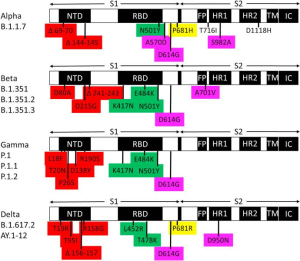A group from University of Florida College of Medicine, Gainesville, FL, USA, has summarized relationship between SAS-CoV-2 mutations and those related concerns.
https://www.ncbi.nlm.nih.gov/pmc/articles/PMC8606318/
Mutations in the RBD
RBD mutations (such as K417 N, L452R, E484K) have the potential to influence neutralizing antibody binding. One RBD mutation, N501Y, was shown to increase the affinity of the spike protein for the host receptor ACE2. These advantageous mutations acquired in the spike protein S1 NTD and RBD possibly enhance receptor/co-receptor binding.
Mutations in the NTD
Although it is clear why mutations in the RBD have the potential to change virus fitness (by altering neutralizing antibody and host cell ACE2 binding), it is not clear why advantageous distinguishing mutations are emerging in the NTD. Since SARS-CoV-2 elicits neutralizing antibodies that bind multiple epitopes on the spike protein, including the NTD, it is very much likely that the NTD participates in an important but unknown function related to virus fitness (e.g., co-receptor binding).
Mutations at interchain contacts in the spike protein trimer
A570D, D614G, A701V, D950 N, and S982A are located at interchain contact sites. The substitutions at spike trimer interfaces likely reduce intermolecular binding affinity. These acquired mutations likely destabilize the spike protein in a manner that enhances dynamic virus processes including spike protein cleavage, structural rearrangement and host cell fusion mechanisms.
Mutations in the furin cleavage site
Mutations in position 681 of the spike protein can be seen in the highly transmissible alpha and delta variants, but not less transmissible variants of concern, beta and gamma. Position 681 is located adjacent to the RRAR proprotein convertase motif (furin cleavage site) considered a hallmark of high pathogenesis. Since endosomal S1/S2 cleavage occurs in an acidified environment, positively charged amino acids at position 681 in highly transmissible variants (H in alpha, R in delta) have the potential to influence the rate of spike protein cleavage and subsequent membrane fusion mechanisms to gain cell entry.

